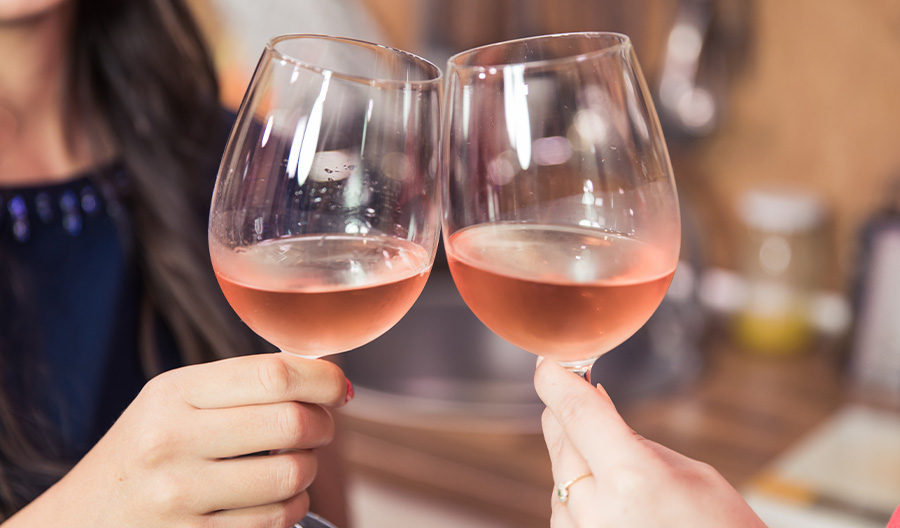Extra dry rosé wine is a unique category within the broader rosé wine spectrum. It is distinguished by its sugar content, which is higher than that of brut rosé but less than that of demi-sec. Despite its name, 'extra dry' in the wine world actually refers to a wine that has a slight sweetness, with sugar levels typically between 12-17 grams per liter.
The production method can also differentiate extra dry rosé from other rosés. While there are several ways to produce rosé wine, including the saignée and skin contact methods, the traditional method of production for extra dry rosé often involves a second fermentation process, similar to that used in Champagne. This can add complexity and depth to the wine, setting it apart from its counterparts.
Extra dry rosé wines are also known for their balance. While they do contain a higher level of sugar, this is often offset by a higher acidity. The result is a wine that, while slightly sweet, does not come across as overly so. Instead, it tends to have a crisp, refreshing quality that can make it an excellent choice for a variety of food pairings.
The flavor profile of extra dry rosé is another distinguishing factor. These wines often have more pronounced fruit flavors, such as strawberry, raspberry, and cherry, due to the higher sugar content. However, they also often exhibit notes of yeast and bread from the second fermentation, providing a balance of flavors that is both complex and appealing.
The Production Process
The production process of extra dry rosé wine begins with the selection of grapes. The most commonly used are red wine grapes, such as Grenache, Syrah, and Pinot Noir. However, the choice of grape variety can vary depending on the region and the specific flavor profile desired by the winemaker.
The next step is the crushing of the grapes. This process releases the juice from the grapes, which is then collected. Unlike red wine production, the skins of the grapes are not left in contact with the juice for a long time. This is because the color of rosé wines comes from the skins, and a prolonged contact would result in a darker, more tannic wine.
After crushing, the juice is left to macerate with the grape skins for a short period, usually a few hours. This process, known as maceration, allows the juice to absorb color and flavor from the skins. The length of the maceration period can greatly affect the final color and taste of the rosé wine.

Following maceration, the juice is then separated from the skins in a process known as pressing. The juice is then transferred to a fermentation vessel, often a stainless steel tank, where it undergoes fermentation. During this process, yeast is added to the juice, which converts the sugars in the juice into alcohol.
The fermentation process for rosé wine is typically conducted at a lower temperature than that for red or white wines. This helps to preserve the delicate flavors and aromas of the rosé. Once fermentation is complete, the wine is usually left to age for a short period before bottling.
Extra dry rosé wine, despite its name, is not completely devoid of sweetness. The term 'extra dry' in the context of wine refers to the residual sugar content. This means that after the fermentation process, a small amount of sugar remains, giving the wine a hint of sweetness. However, the overall taste profile of an extra dry rosé is more on the dry side, with a crisp and refreshing finish.
Finally, the wine is filtered and bottled. The bottling process often involves the addition of a small amount of sulfur dioxide, which acts as a preservative to maintain the wine's freshness and longevity. After bottling, the wine is usually left to rest for a few more weeks or months before it is ready for consumption.
Food Pairings
Extra dry rosé wine, with its crisp acidity and versatile flavor profile, pairs exceptionally well with a variety of foods. One of the most classic pairings is with seafood. Whether it's grilled shrimp, seared scallops, or a fresh ceviche, the wine's acidity complements the delicate flavors of the seafood.
Another great pairing for extra dry rosé is with light meats like chicken or turkey. The wine's crispness cuts through the richness of the meat, creating a balanced and satisfying flavor combination. This makes it a perfect choice for summer barbecues or picnics.
Cheese is another food that pairs well with extra dry rosé. Soft cheeses like brie or camembert, in particular, work well as the wine's acidity cuts through the creaminess of the cheese. The wine also complements harder, aged cheeses like cheddar or gouda.
Extra dry rosé also pairs well with a variety of salads. Whether it's a simple green salad, a hearty grain salad, or a tangy coleslaw, the wine's acidity and light fruit flavors complement the fresh and often tangy flavors of the salad.
Don't forget about dessert. Fruit-based desserts like a fresh fruit tart or a berry crumble are a perfect match for extra dry rosé. The wine's acidity balances the sweetness of the dessert, while its light fruit flavors echo the fruit in the dessert.

